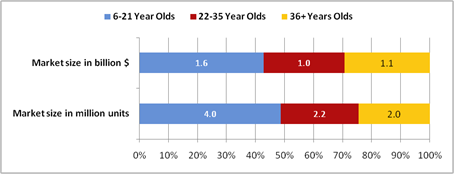The Current Customers of the Industry
The core customer group is about 20% of the total available market. Currently it is split approximately 63:37 male:female.
Most customers fall into the 10-45 age bracket, half of these under the age of 21. However, the market has been aging as young gamers in the 1980s are now wealthy and are able to pay for an improved gaming experience in terms of game complexity, visual definition, realism and sound quality – gaming is part of the relaxation at the end of a hard day’s work. These customers are also willing and able to buy consoles for their children.
The core customer group is very internet-savvy and enjoys playing within the recently available online gaming communities. They are able to meet with and play with or against other gaming enthusiasts from all over the cyber world at any time of day or night.
The one thing that customers do complain about is the lack of availability of really good games. The majority of available titles style the gamer as a person with weapons, ‘life’ credits and sets of tasks to perform to progress from one level to the next in the game. The task is to avoid being damaged or ‘killed’ while solving how to progress to the next level of the game. This can involve much repetition – however a recent survey revealed that, for some customers, the repetitive nature of button-pressing and repetition of actions at any one level in the game provides a soothing effect on the player.
The hand-held controllers have become more and more sophisticated, with many buttons located on their different faces – usually more buttons than the fingers on both hands. The attraction and complexity of a game are partly dependent upon all of the functions that these buttons offer and how game programmers are able to use the console’s control language to exploit all the options that the buttons offer.
The market is divided into three major groups of customers, or segments, each having similar needs and purchasing behavior. The major defining demographic of each segment is age.
The sizes of these groups (in volume and value) are given below, and a detailed description of each group follows.

Figure 3 – Size in volume and value of the three groups of existing customers
